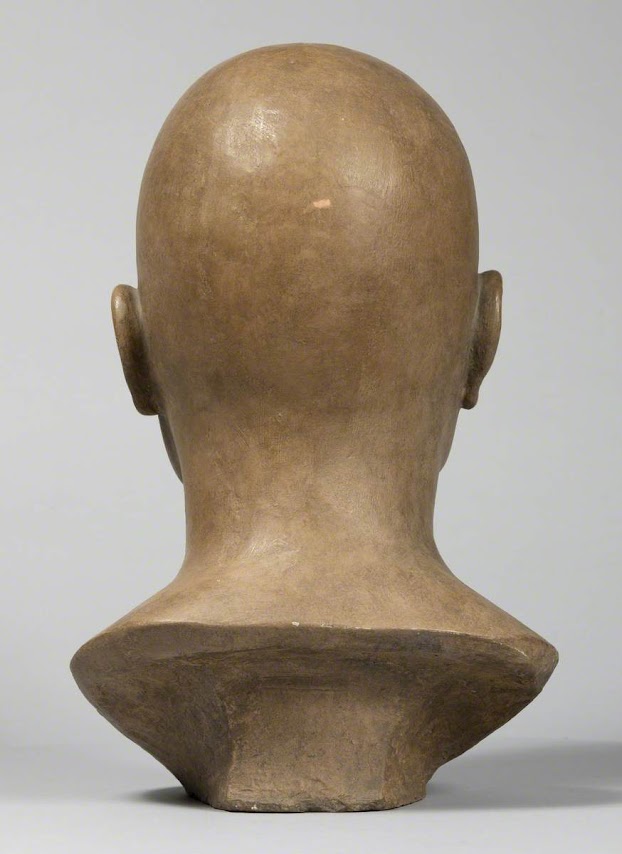Oliver Cromwell
A Terracotta Bust
It has been suggested that the original bust in the Bargello was modelled from a death mak by Bernini.
Supposedly reproduced from a death mask - where is his beard???
H 39 x W 24.3 x D 24.2 cm
Sidney Sussex College, University of Cambridge.
Photographs and details of this bust were recently added to the Art UK sculpture database website
see - https://artuk.org/discover/artworks/oliver-cromwell-15991658-268501
A gift from Professor Thomas Martyn, 1801.
From the collection's object label:
'Bought by Thomas Martyn
in 1797 from Mr. White, a bookseller of Fleet Street who acquired it at a sale
of unclaimed goods at the Custom House and who thought it to have been copied
from the bust in the Palazzo Vecchio, which was executed by Bernini from a
death mask'.
I have already written a substantial amount on the iconography of Oliver Cromwell
see my blog post below on my parallel blog and 23 further posts between November 2018 and June 2019
https://english18thcenturyportraitsculpture.blogspot.com/2018/11/bust-of-cromwell-by-roubiliac-at.html
There are many versions of the Oliver Cromwell death mask - a subject I do not intend to go into here but suffice to say they all have beards!!
For a very short video about the head of Cromwell see -
https://www.youtube.com/watch?v=jXrMRNpjn70&feature=emb_title
______________________
The Head of Oliver Cromwell.
Terracotta? with Glass Eyes.in the Bargello Museum,
Florence.
Supposedly in the museum since 1738
Catalogue Reference:
HC/LB/1/111/14/10
Former Archival Reference:
House of Commons Library Ms 111, Box 14, Photograph 10
http://digitalarchive.parliament.uk/HC/LB/1/111/14/10
___________________
Illustration above from
Walpole Soc Journal 1952 - 54.
__________________
Image of the Bargello head above from
https://erenow.net/biographies/cromwellourchiefofmen/30.php
_______________
From the funeral Effigies of Westminster Abbey by Anthony Harvey, Richard Mortimer · pub 2003
_______________________
Oliver Cromwell.
Bust in the possession of the Duke of Grafton
by John Keyse Sherwin (1751 - 1790).
Stipple engraving,
late 18th century
7 in. x 5 3/8 in. (177 mm x 138 mm) paper size.
The bust was some time at Wakefield Lodge, Pottersbury,
Towcestere, Northamptonshire. Originally built by John Claypole, the son in law
of Oliver Cromwell. Acquired from the Crown in 1712 - the Duke of Grafton
rebuilt it in 1749 (it was mostly demolished in 1949 - a wing by William Kent
survives).
In 1785 the bust was in the Piccadilly town house of the
Duke of Grafton and is described in Memoirs of the Protectoral-House of
Cromwell by Mark Noble, published in 1785, (pages 303 and 304) - as being of plaster, coloured to represent
brass, an exact likeness of the bust in Florence.
__________________
Cromwell
Plaster Cast
Height 277 mm.
Provenance H. Hubert Cust, from whom purchased 1899.
National Portrait Gallery.
info below from the NPG
Another of these casts was sold by Sotheby's New York, 10 January 1995, lot 67.
From the painted gesso bust with glass eyes in the Bargello,
Florence; a version belonging to the Duke of Grafton was engr. J. K.
Sherwin c.1780, another sold Sotheby’s NY, 10 January 1995, lot 67.
1) K. Pearson & G. K. Morant, ‘Portraiture of Oliver Cromwell’, Biometrica, XXVI, 1935, pp 92-93; D. Piper, ‘The contemporary Portraits of Oliver Cromwell’, Wal. Soc., XXIV, 1958, no.13, pl.xiii; exh. Firenze e l’Inghilterra, 1971, no.19.
K. Pearson & G. K. Morant, ‘Portraiture of Oliver
Cromwell’, Biometrica, XXVI, 1935, pls.lxxxii,lxxxiii.
________________________
Horace Wilkinson
For the so called Wilkinson head of Cromwell interred at the Sidney Sussex College in 1960
see the sceptical post
https://etinkerbell.wordpress.com/2014/12/14/the-incredible-story-of-oliver-cromwells-head/
The Portraiture of Oliver Cromwell With Special Reference To
The Wilkinson Head
Karl Pearson and G M Moran Published by London - Biometrika Office, 1935
Is a scarce work on Oliver Cromwell and authenticity of the Wilkinson Head. With 107 plates. Following the death of Oliver Cromwell on 3 September 1658, he was given a public funeral at Westminster Abbey, equal to those of monarchs before him. When the monarchy was re-established and King Charles II, who was living in exile, was recalled, Charles' new parliament ordered the disinterment of Cromwell's body from Westminster Abbey and the disinterment of other regicides John Bradshaw and Henry Ireton, for a posthumous execution at Tyburn. The heads of the traitors were placed on spikes above Westminster Hall and, after a storm in 1685, the head was removed and passd through various collectors and museum owners with some controversy.
after spending 28 years on the spike it disappeared only to reappear exhibited in a private museum in London, owned by a Swiss-French collector named Claudius Du Puy.
Josia Henry
Wilkinson purchased the head in 1815, and for the next century there was some
back and forth as to whether it was the true head of Cromwell. Scientific and
archaeological analysis was carried out to prove the identity. Inconclusive
tests culminated in a detailed scientific study by Karl Pearson and Geoffrey
Morant, which concluded, based on a study of the head and other evidence, that
there was a 'moral certainty' that the head belonged to Oliver Cromwell.
The gruesome illustrations below from this publication



















No comments:
Post a Comment